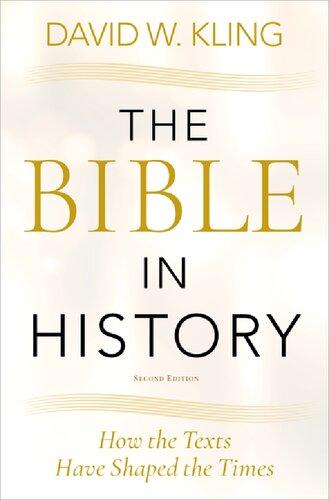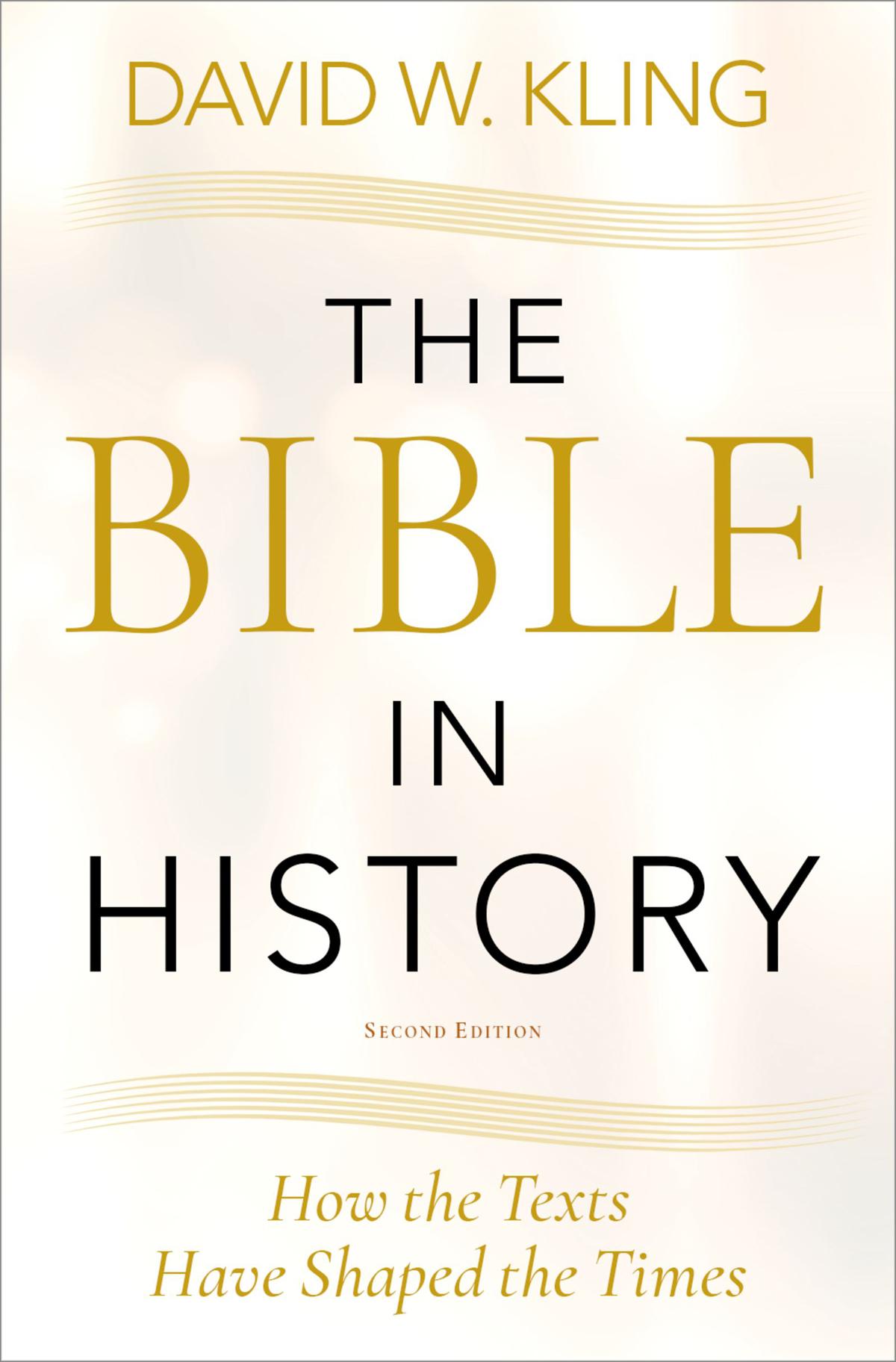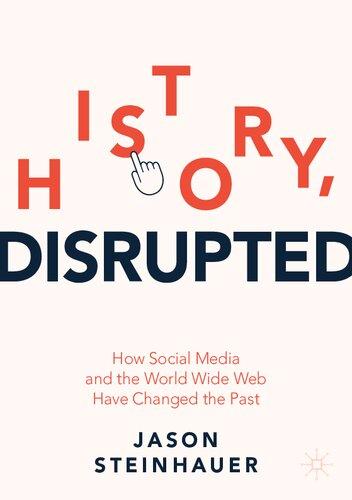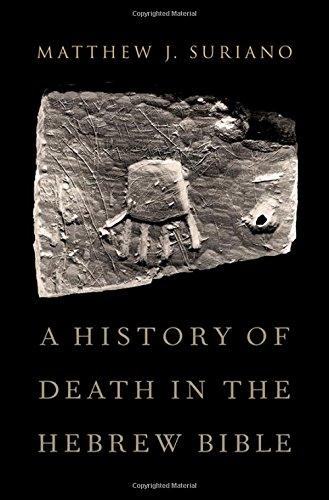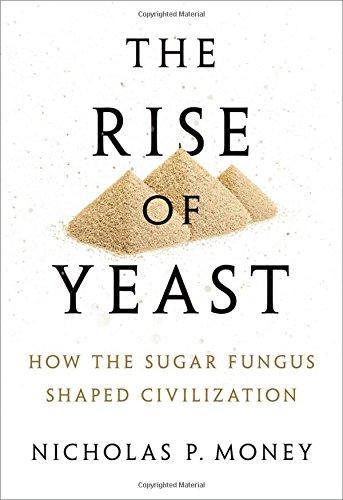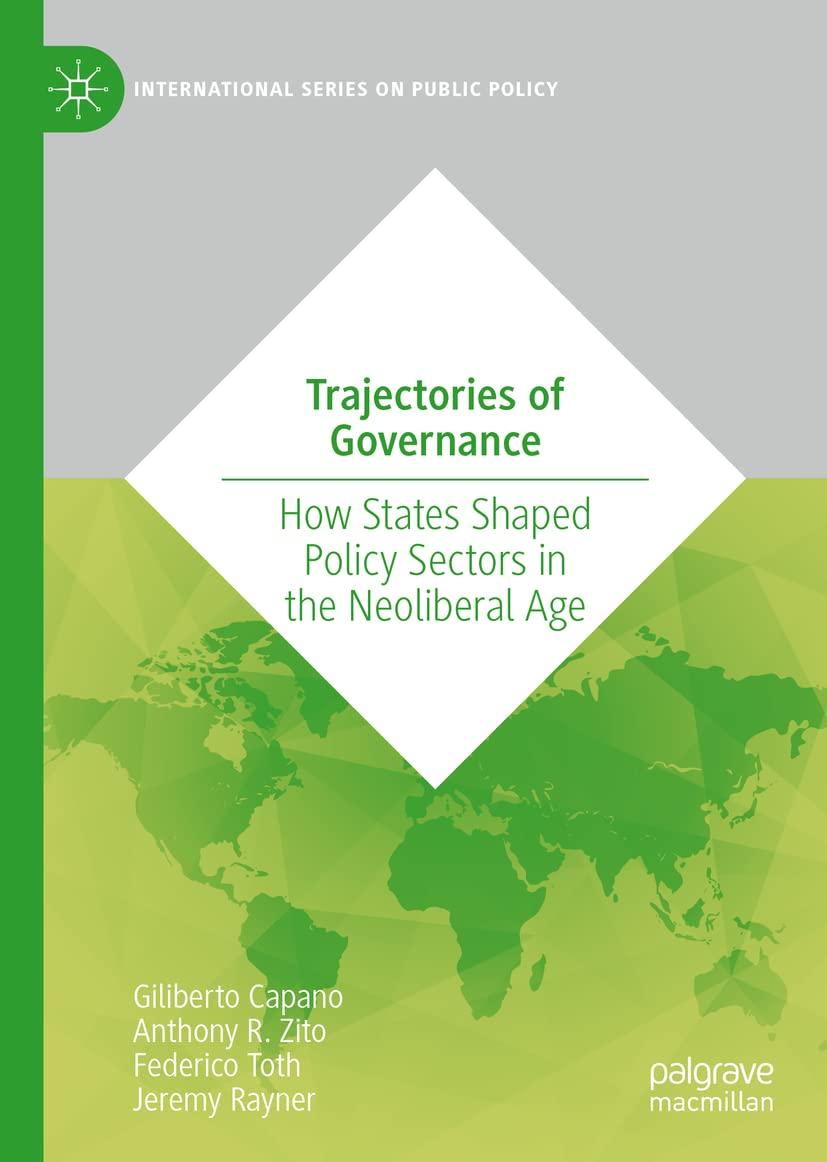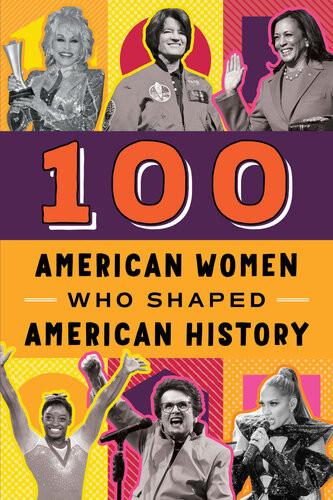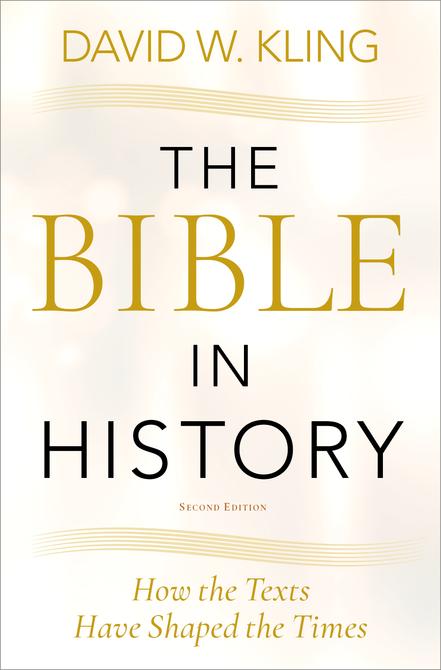Acknowledgments
As the reader will observe from textual references and endnotes, this work is greatly indebted to the scholarship of others. It is also indebted to the suggestions, insights, and assistance of numerous other people. Apart from my own earlier ruminations on this project (discussed in the Introduction), an impetus for this book came in 1994 from John Corrigan, whose manuscript draf of the “Christianity” section in the subsequently published Jew, Christians, Muslims: A Comparative Introduction to Monotheistic Religions (Prentice-Hall, 1998) I was asked to review. Corrigan’s attention to the role of Scripture in the history of Christianity, though not extensive, meshed with my own embryonic thoughts about the role of Scripture in Christian history. I wondered, could a more comprehensive story of the Bible’s infuence in Christian history be told in a way that would at once blend history and hermeneutics? Could I ofer some insight into why a particular biblical text came to the fore, was given a particular interpretation, and subsequently infuenced the course of Christian history? What follows, of course, is an answer to these and many other questions raised by the readers and listeners of presentations of this book in its various stages of development.
I frst tried out the general shape of this book in two settings—ecclesiastical and academic. For listening patiently to underdeveloped ideas and prodding greater clarity of expression, I thank the participants in a 1996 adult education class at Immanuel Presbyterian Church (Miami) and students in a 1998 fall seminar at the University of Miami. Among the latter, I gratefully acknowledge the indulgence of Glaister Brown, Scott Chadda, Jessica Gilbride, Kateri Hilton, Nathan Novak, Kristen Oostdyk, Jenny Reider, and Renata Schwedhelm. Another student, Sarah Tompson Chule, rendered helpful bibliographic assistance and commented on several chapters. Tanks also to Alex Cuenca, my student assistant, for reconfguring the manuscript to conform to the guidelines of Oxford University Press.
A number of colleagues, known and unknown to me personally, took time away from their own work to lend assistance. For adding conceptual clarity to this project, I thank Mark Noll and several anonymous readers for Oxford University Press. Henry Green, Dexter Callender, Nancy Hardesty, Daniel Pals, Willard Swartley, and Michael Westmoreland-White ofered bibliographic suggestions and/or clarifcations on portions of chapters. Bernard McGinn, Mickey Mattox, Douglas Sweeney, Martin Marty, J. Denny Weaver, Stuart Murray, Arnold Snyder, Will Coleman, and Douglas Jacobsen read and commented upon individual
chapters. I have also beneftted from conversations with long-time friends Bruce Hultgren and David and Margo Miller.
To three scholars and friends who read the entire manuscript, I express my heartfelt thanks. In his usual timely and efcient manner, Craig Blomberg ofered balanced judgments and bibliographic suggestions. I am especially grateful to two colleagues in the Department of Religious Studies at the University of Miami. With the eye of an assiduous editor, Stephen Sapp combed through the entire manuscript and saved me from infelicities in grammar and diction. John Fitzgerald plunged me deeper into the complex world of biblical scholarship, ofered extensive, thought-provoking comments, saved me from embarrassing blunders, and heightened my respect for his own feld of biblical studies.
Te stafs of several libraries answered queries and ofered much-needed assistance. Tanks to the library personnel and specialists at St. John Vianney College Seminary (Miami), Western Michigan University, Associated Mennonite Biblical Seminary, and especially the University of Miami, whose staf processed hundreds of interlibrary loan requests.
Several other people and institutions deserve special thanks for their encouragement and largesse. I probably would not have written this book if it were not for Cynthia Read of Oxford University Press, whose enthusiastic endorsement of this project in its prospectus stage enabled me to work with the confdence that what I was doing would eventually appear in print. I could have not sustained this project without the fnancial assistance of several granting agencies. Te University of Miami supported this work through a summer Max Orovitz Research Grant and a General Research Grant for travel. I am especially grateful to the Lilly Endowment–funded Louisville Institute for its generous Christian Faith and Life Sabbatical Grant that enabled me to devote the 1999–2000 academic year to this project.
Family members did not contribute anything directly to this work, but I have been sustained by their love in the realization that the meaning of human relationships far exceeds the meaning of texts. Parents-in-law Gordon and Phyllis Bacon deserve special recognition for their care and support through the years. Tanks to my children—Elizabeth Corson, Justin Kling, Phillip Kyrk, and Hannah Kling—for enriching life in so many ways and ofering a welcomed respite from “another day at the ofce.” A thank you hardly expresses appreciation to my wife, Barbara, who has graced my life and on numerous occasions adjusted her busy schedule to accommodate my scholarship.
Tis book is dedicated to parents whose call to serve and minister in the Christian church inspired me in the pursuit of another, though not unrelated, calling. It is to them that I owe my frst exposure to the Bible.
Abbreviations
AB Anchor Bible
ABR American Benedictine Review
ACW Ancient Christian Writers: Te Works of the Fathers in Translation. Edited by J. Quasten et al. 55 vols. New York: Newman; Mahwah, N.J.: Paulist, 1946–.
ANF Ante-Nicene Fathers: Translations of the Writings of the Fathers Down to A.D. 325. Edited by Alexander Roberts and James Donaldson. 10 vols. 1885–96. Reprint, Grand Rapids, Mich.: Eerdmans, 1978–79.
ANTC Abingdon New Testament Commentaries
BNTC Black’s New Testament Commentaries
BTB Biblical Teology Bulletin
BJRL Bulletin of the John Rylands University Library of Manchester
CFS Cistercian Fathers Series
CGR Conrad Grebel Review
CH Church History
CS Cistercian Studies
CSS Cistercian Studies Series
CWS Classics of Western Spirituality: A Library of the Great Spiritual Masters. Mahwah, N.J.: Paulist, 1978–
FC Fathers of the Church
FCB Feminist Companion to the Bible
GNC Good News Commentary
HTR Harvard Teological Review
IB Interpreter’s Bible. Edited by G. A. Buttrick et al. 12 vols. New York: Abingdon, 1951–57.
IBCR International Bulletin of Missionary Research
ICC International Critical Commentary
ITC International Teological Commentary
JAAR Journal of the American Academy of Religion
JAH Journal of American History
JBC Jerome Biblical Commentary. Edited by Raymond E. Brown et al. Englewood Clifs, N.J.: Prentice Hall, 1968.
JBL Journal of Biblical Literature
JES Journal of Ecumenical Studies
JETS Journal of the Evangelical Teological Society
JPT Journal of Pentecostal Teology
JPTSS Journal of Pentecostal Teology Supplement Series
JR Journal of Religion
JRS Journal of Roman Studies
JSNT Journal for the Study of the New Testament
JSNTSS Journal for the Study of the New Testament Supplement Series
JTS Journal of Teological Studies
LCC Te Library of Christian Classics. Edited by J. Baillie et al. 26 vols. Philadelphia: Westminster, 1953–66.
LCL Loeb Classical Library
LQ Lutheran Quarterly
LW Luther’s Works, American Edition. Edited by Jaroslav Pelikan, vols. 1–30; Helmut T. Lehman, vols. 31–55. St. Louis: Concordia, and Philadelphia: Fortress (formerly Muhlenberg Press), 1955–86.
MFC Message of the Fathers of the Church
MQR Mennonite Quarterly Review
MS Monastic Studies
NCB New Century Bible (Commentary)
NICNT New International Commentary on the New Testament
NICOT New International Commentary on the Old Testament
NIGTC New International Greek Testament Commentary
NPNF A Select Library of the Nicene and Post-Nicene Fathers of the Christian Church. Edited by Philip Schaf et al. 2 series (14 vols. each). 1887–94. Reprint, Grand Rapids, Mich.: Eerdmans, 1952–56.
NTM New Testament Message
OTG Old Testament Guides
OTL Old Testament Library
Pneuma Pneuma: Journal for the Society of Pentecostal Studies
PSB Princeton Seminary Bulletin
SAC Studies in Antiquity and Christianity
SP Sacra Pagina
SEC Studies in Early Christianity: A Collection of Scholarly Essays. Edited by Everret Ferguson. 18 vols. New York: Garland, 1993.
StPatr Studia Patristica
TTo Teology Today
TLS Teology and Life Series
TNTC Tyndale New Testament Commentaries
TOTC Tyndale Old Testament Commentaries
TPINTC TPI New Testament Commentaries
TS Teological Studies
WBC Word Biblical Commentary
WC Westminster Commentaries
Introduction
Te basic idea for this book originated in the classroom. During my teaching career, I have taught in two kinds of educational environments: one a private, nonsectarian university, the other a variety of Christian settings, including a Protestant college, a Catholic seminary, and a number of Protestant churches. In my experience, students in both groups labor under misapprehensions that, although quite diferent, are related. On the one hand, university students may learn something from a course in the history of Christianity, but when the last assignment is completed and the fnal exam taken, they have little knowledge of the Bible’s relationship to developments in the history of Christianity. Ironically, it is as if the Christian faith, ofen labeled a “religion of the book,” were beref of a guiding sacred text throughout its history. On the other hand, although students in Christian educational settings have a working knowledge of the Bible, they have little understanding of how various biblical texts have been interpreted and applied throughout history. For them there is a diferent irony: it is as if the Christian faith, ofen called a “historical religion,” were devoid of twenty centuries of history. And so the idea occurred to me, now expressed in the pages that follow, to make some attempt to bridge the gap between Scripture and its place in the history of Christianity.
Given the specialties and subspecialties of the feld, historians of Christianity seldom venture into the discipline of biblical scholarship. In fact, a perusal of general works on the history of Christianity turns up limited references to the impact of the Bible as a formative infuence in Christian history. Apart from a discussion of the formation and role of sacred texts as they relate to the early Christian community and a comment on Luther’s “evangelical breakthrough” in his reading of Romans 1:17, few narratives on the history of Christianity consider specifc biblical texts in any depth. Biblical scholars, although they are attuned to historical developments, typically focus on the original Sitz im Leben the life setting in which the text was produced and used—rather than on the appropriation and application of a text in subsequent history.
Several consequences arise from detaching biblical texts from their application in diverse historical contexts. For one, such neglect creates a false impression that sacred texts are static, stable entities, that they function independently of time and place. But this has never been so. First, the Bible itself is embedded in a variety of cultural contexts and refects the infuences of its social settings. Second, because of the changing nature of life itself, nearly every generation of Christians
The Bible in History. David W. Kling, Oxford University Press. © Oxford University Press 2023. DOI: 10.1093/oso/9780197525364.003.0001
has reinterpreted Scripture (with varying degrees of self-awareness) in order to make the Bible relevant to their concerns. Tis interpretive task is precisely what the hermeneutical enterprise endeavors: to understand how a biblical text is to be interpreted and applied in the present-day situation.1 In the words of Paul Ricoeur, “Hermeneutics is the very deciphering of life in the mirror of the text.”2 We decipher life by carrying on a dialogue with the text about our world and its world.
Consider the example of Anthony, the subject of the frst chapter. Afer hearing the words of Jesus, “If you wish to be perfect, go, sell your possessions, and give the money to the poor, and you will have treasure in heaven,” this obscure Egyptian Christian in the late third century took this advice with a literalminded passion. He gave away his possessions, lef the civilized world, headed to the desert, and became the putative founder of the monastic movement. Troughout the centuries, however, other Christians have understood Jesus’ words to the rich young man quite diferently, and, in fact, some see in Anthony a perversion of Jesus’ intent. No, they argue, Anthony was more infuenced by his surroundings (e.g., a general ascetic environment) than he was by a correct reading of the text. What, then, was the rise of monasticism? A continuation of themes adumbrated in the New Testament, an unwitting concession to the ascetic milieu of the ancient world, or some combination? Such questions prompt other questions engaged throughout this book. Why do particular texts become the focus of attention? What factors give rise to a new understanding of a text? What traditions or pre-understandings does an interpreter bring to the text? How do we understand the interaction between text—be it in oral form as in Anthony’s case or in written form as in Luther’s—and the interpreter? Who discerns the correct meaning of a text—the learned, the pious, the ecclesiastical authorities, the poor, the marginalized? Is there a single meaning, or are there multiple meanings to the text?3
As a work of both history and biblical studies, this book addresses the history of ten texts—in some cases a single text, in others clusters of related texts, and in still others, whole chapters or large portions of a particular book in the Bible. Although I discuss my criteria for choosing particular texts later, the necessary limitation of texts indicates that this study is intentionally episodic, illustrative, and selective rather than exhaustive or comprehensive in scope. Dozens, even hundreds, of texts have exerted infuence in the history of Christianity (though exactly how one measures infuence is not easy to defne). In tracing the history of ten texts, I ofer not so much an introduction to the history of biblical interpretation as “the operation of taking soundings”4 or identifying certain texts at certain moments in history that resonate (“sound”) in the lives of individuals and extend to a larger Christian community. Each chapter is shaped roughly like an hourglass. Tat is, I trace the history of a text on either side of a particular episode in which the text undergoes an innovative interpretation. Tis critical
juncture—the neck of the hourglass—becomes the primary focus of attention in each chapter.
As noted, the concerns of this book address a wide audience of nonprofessionals (students, informed laypeople) and scholars. For the uninitiated in the academic guild, as well as for instructors who may wish to use this book as a supplement to other reading or to assign only selected chapters, I have sought to provide sufcient historical background so that each chapter stands alone as a discrete unit. Where possible, I have also sought to avoid the technical language and apparatus that characterize contemporary biblical studies.
At the same time, by undertaking an interdisciplinary study of history, theology, and biblical studies, I hope to ofer scholars new ways of thinking about the function of sacred texts within the cultural communities that engage and appropriate them. Historians, biblical scholars, theologians, and ethicists will obviously fnd some things that are familiar to them, but this work of synthesis is intended to broaden their interdisciplinary horizons. For example, this project extends the previous work of Gerhard Ebeling, Karlfried Froelich, Ulrich Luz, Roland Murphy, and recent scholars (primarily biblical) who have expressed a renewed appreciation for the Wirkungsgeschichte, or history of the efects that Scripture has produced in many contexts throughout the history of Christianity.5 My work difers from theirs, however, in its focus on the role of a biblical text in a particular historical episode; that is, a historical event or development is the framework for the understanding and application of a biblical text.
Ebeling envisioned the history of Christianity as the complex interplay of selfunderstanding and biblical interpretation, but as Froelich has remarked, “Tere seems to be no comprehensive attempt anywhere to write church history from the angle of the history of the exposition of Scripture. Ebeling himself . . . never tackled the task.”6 Afer working on this project for a number of years, I think I know why. Te task is simply too daunting. Te infuence of hundreds of texts upon thousands of individuals and groups over the course of two thousand years is a challenge too big for any one individual to comprehend.
In its attention to “hourglass episodes,” this book proceeds chronologically. I have applied three criteria in selecting such episodes.
1. Signifcance. Te primary criterion of selection is the extent to which an interpretation or application of a biblical text signifcantly shaped or was invoked as a critical text in the subsequent history of Christianity. I am not suggesting that great shifs in the Christian church necessarily turn on important biblical texts, for great shifs tend to be attitudinal and general in scope. As the historian Edmund Morgan observes, “Change in Christian thought, even so radical a change as in the Reformation, has usually been a matter of emphasis, of giving certain ideas a greater weight than was previously accorded them or of carrying one idea to its logical conclusion at the expense of another.”7 During
such upheavals, a specifc scriptural text is cited (e.g., Luther’s use of Rom. 1:17), brought to bear on the situation, and accorded a special status, ofen thereby assuming a paradigmatic quality. Reasonable people will disagree about what events I deem signifcant—perhaps more about what I have lef out than what I have included—but my list generally accords with the consensus of other historians of Christianity and biblical scholars concerned with the history of texts. Space limitations required eliminating a number of texts and episodes of comparable signifcance to those that are included.8
2. Diversity of traditions and texts. I have taken into account the major Christian traditions, though with diferent degrees of emphasis roughly proportionate to my assessment of each tradition’s historical impact. I have also selected a variety of settings among diverse peoples, although emphasis is given to American developments for reasons of my own academic expertise and the intended reading audience. In addition, I have chosen a variety of scriptural genres such as narrative, poetry, and didactic literature.
3. Interpretive strategy and varied themes. I have selected incidents that demonstrate a cross section of exegetical and hermeneutical approaches, be they simplistic or sophisticated. Moreover, I have chosen episodes that illustrate the varied application of scriptural texts in matters related to church polity (chapters 2, 8), theology (chapter 4), missiology (chapter 9), ethics (chapters 1, 5, 6, 10), and religious experience (chapters 3, 7). Some texts have been a source of comfort; others have been a source of social transformation; still others have been the basis of revolutionary behavior.
As I have intimated, this book is less concerned with the most accurate or latest critical understanding of a sacred text than with the way a text was appropriated by an individual or a community. Along the way I consult biblical scholars and literary critics and apply their insights to establish a modern critical reading of the text. However, this approach is of secondary importance to discerning the impact of a text within a particular historical setting. From the perspective of some biblical scholars, this approach may appear to be an irrelevance, especially if a text was grossly misunderstood in light of modern historical-critical scholarship.9 Why should anyone care about the infuence of a fawed interpretation of Scripture? But raising this question gets to the very heart of what this project is about, namely, describing the assumptions, presuppositions, or mentalité by which Christians apprehend a sacred text and live out its teachings. Experience accompanies and even informs these assumptions to create a dynamic interplay among belief, experience, and Scripture. Put another way, on some occasions Scripture confrms one’s predispositions; on others, it challenges or alters them. Te dynamics of scriptural interpretation point to the fact that a sacred text, as with all literature, is contested territory. And truth be faced, it is no less hotly contested among contemporary scholars.
For readers unfamiliar with the history of biblical interpretation, it may be helpful to note briefy its broad contours.10 Perhaps the simplest way of viewing this complex history is to demarcate the traditional period from the modern period or, to be more precise, to distinguish between the pre-historical-critical (more commonly but less accurately known as “precritical”) and the historicalcritical period. Te latter emerged during the Renaissance and came into its own in the eighteenth and nineteenth centuries. Tis distinction, it should be noted, locates the interpretive enterprise among the learned and privileges their understanding of the Bible. Such is a conventional perspective, for the very existence of a text implies a literate reader, one who is able to discern meaning in the written word. Yet other ways have been proposed. On occasion, especially since the Reformation, there has been the recognition that the Spirit of God enables the unlearned, even the illiterate, to grasp the basic teachings of Scripture. Te crosscultural missionary enterprise has proceeded on this assumption. Troughout Christian history, not only have the learned read the Word, but also perhaps more ofen the ignorant have heard it. Te theme of exodus in the African American experience discussed in chapter 6 highlights the latter perspective. At the same time, in the precritical period, both black slaves and literate Euro-Americans shared the traditional interpretation of Scripture, for both groups afrmed that the words and sentences (as heard or read) accurately described real events and real truths. Tis assumption underlay the traditional view of the Bible.
Hans Frei has noted three basic elements of the “traditional realistic interpretation of biblical stories.”11 First, the Bible describes actual historical people and events. Tus Moses actually existed, and the exodus event actually occurred as described. Second, a single narrative, what has been called a “grand narrative” or “metanarrative,” holds the Bible together. For Christians, this narrative is the story of redemption, foreshadowed and anticipated in the Old Testament and fulflled in the New with the coming of Christ. Tus Moses, in leading the people of Israel to the Promised Land, foreshadows or prefgures Christ, who led his followers to the heavenly Promised Land of the celestial city. Te story of Moses was indeed true, but it also prefgured the larger narrative of Christ’s redemptive work. Tird, if the world as described in the biblical narrative is “the one and only real world,” then its message transcends time and space. Te reader sees her own life, attitudes and actions, motivations and behavior, in the biblical narrative. All of life is fltered or understood through this real biblical world.12
We see this view of Scripture embedded in the New Testament itself. Trough a typological (or fgurative) and christological interpretation of the Old Testament, the authors of the New Testament believed that the Hebrew Scriptures anticipated or foreshadowed the coming of Christ. For example, in Luke 4:16–19, Jesus quotes from the Book of Isaiah (61:1–2; 58:6) to announce that “today this scripture has been fulflled in your hearing” (Luke 4:21). Te
author of Hebrews envisions the prophecies and promises of the Old Testament fulflled in the “new covenant” that now through the unique priesthood of Christ superseded the old Jewish system. Paul draws a correlation between Adam and Christ (the new Adam) and between Israel and the church (the new Israel). Even as the New Testament emerged, its writers were conscious that all of Scripture bore the imprint of God’s salvation history that culminated in Christ.
In the early church, two understandings of Scripture predominated. Both refected continuities with the early hermeneutical approaches of Jewish rabbis, ancient philosophers, and the writers of the New Testament. Te literal approach, which ofen bordered on extreme literalism, referred to what the divinely inspired author intended to convey by what he wrote. It involved the meaning of the smallest of units (words, phrases, sentences) and extended to paragraphs, chapters, and whole books. Tis textual meaning or contextual meaning communicated belief in the divine origin, authority, and trustworthiness of Scripture. Te other way of interpreting Scripture, one that reached its greatest expression during the medieval period, was the spiritual or allegorical meaning of the text. In this reading, the text pointed to Christ or some higher, deeper, or hidden spiritual truth than was contained in the literal sense. Whether a reader approached Scripture in a literal or spiritual way, both patristic and medieval interpreters assumed that the normative sense of Scripture must accord with the rule of faith, that is, with what Christians believe and the church teaches.
Under the infuence of John Cassian (ca. 360–435), these two modes of interpretation expanded into what became known as the medieval fourfold sense of Scripture: the letter (facts), allegory (what is to be believed), the moral (what one is to do), and the anagogical (what is hoped for). As we will see with Bernard of Clairvaux in chapter 3, the literal sense was not abandoned but ofen was obscured or neglected because of what the other senses ofered the interpreter: an elasticity of interpretation that fed the imaginative and creative spiritual juices of the commentator. A text had not one but multiple meanings, and together these conveyed a variety of truths, though all pointed to the one Truth. To be sure, commentators who followed this fourfold interpretive scheme engaged in fights of fancy, but their fdelity to Catholic dogma reined in the possibility of heterodox interpretations.
In varying degrees, the application of modern critical methods to understanding the Bible—“critical” because these methods applied literary, grammatical, scientifc, and technical methods to the ancient text and made judgments about it (“critical” comes from Greek, krisis = judgment)—challenged the traditional ways of viewing the Bible. With the Renaissance cry of ad fontes (“to the sources”) came a renewed interest in the meaning of original ancient texts and other sources. Scholars, notably Desiderius Erasmus (1466–1536) and John Colet (1466–1519), began to read Hebrew and Greek, the original languages of
the Bible that had been largely ignored (or were unavailable) in the West since Jerome’s Latin translations in the fourth century. Tis attention to the ancient languages resulted in a greater interest in the original meaning of the text (i.e., the author’s intention) and in the minimization (though not the abandonment) of the allegorical interpretation. Te contributions of the Protestant Reformers Martin Luther and especially John Calvin proved decisive in establishing the grammatical-historical method. Calvin wrote commentaries on nearly every book of the New Testament wherein, like Luther, he stressed the necessity of historical and literary context, as well as the analogy of faith (i.e., Scripture is interpreted by other like passages of Scripture).
Reacting to the Protestant stress on the literal sense of Scripture, Catholics continued to emphasize the value of the allegorical as the traditional timehonored interpretation. Still, the literal (plain) sense gained currency, abetted by the eighteenth-century Enlightenment and the subsequent historical and archaeological discoveries that enlarged the contextual understanding of the biblical Near East and uncovered genres of literature (legal, historical, poetic, and wisdom texts) similar to that of the Bible. With these fnds, the allegorical method all but disappeared.
Te modern critical perspective assumes that the events described in the Bible refect a particular historical background. Te Bible did not magically appear or drop down from heaven; rather, its style and content disclosed the cultural settings of the writers. Scripture’s literary forms or genres confrmed its place within the larger context of Near Eastern culture (Old Testament) and the Greco-Roman world (New Testament). Increasingly, the Bible was subjected to the same rigorous critical scrutiny as other ancient literature. At the same time, its study was increasingly disconnected from church doctrine as academics (with varying degrees of religious commitment) investigated its contents free from the constraints of ecclesiastical boundaries.
In the last two centuries, scholars have raised questions about the Bible’s authorship, date of composition, sources used by the authors, purpose in writing, audience, and genre (style, form, content, function). Some concluded that the diversity and irreconcilable diferences of Scripture were so vast as to rule out any kind of unity—the very unity that informed the traditional view and that Calvin and other Reformers afrmed as the analogy of faith. In some cases, critical methods were joined with naturalist assumptions to yield skepticism regarding biblical miracles and the divine nature of Jesus. John Goldingay observes how this approach difered from the traditional view of the Bible: “In the precritical period interpreters would have taken for granted that there was no distinction between the story told by a biblical narrative and the events that actually took place in biblical times, or between the fgure traditionally associated with a particular book and its actual author. During the critical age it is these distinctions
that have been taken for granted, and the major concern in interpretation of the stories has been to establish and defend views of their historical background and reference.”13 In the traditional view, the exodus was a real event as described; the critical view assumed no such similitude. One might of course reach the conclusion that the exodus was a real event (either in every detail or in a general way)— but only afer subjecting the narrative to critical scrutiny.
It is beyond the scope of this introduction (and the intention of the book) to discuss the complex twists and turns in contemporary biblical scholarship, but several summary observations are in order. First, increasing dissatisfaction with the limits of the historical-critical method, combined with the exposure of biblical scholars to the interpretive methods of the social sciences and literary theory, has resulted in the proliferation of new interpretive approaches. Literary methods, for example, tend to focus on the text itself in its fnal form (not on the pre-text as is the focus of historical methods), the relationships among texts, and the interplay between the text and the reader. In the past half-century, structuralist criticism, narrative criticism, and reader-response criticism, to name several literary methods, have assumed their place alongside conventional historical-critical inquiry. Not just two or four levels of understanding Scripture govern the life of the church or rule the academy; rather, multiple and ofen competing approaches characterize the interpretive enterprise. To be sure, there is general agreement that the historical-critical method is a useful tool and that the primary task of interpreting biblical texts is to determine (or approximate) what the writers were conveying to people in their own time. But an emphasis on the pre-text (e.g., sources and traditions) has been viewed by some scholars as of limited value in establishing the meaning of the existing text. Some have objected that the historical-critical method so brackets the transcendent intention of the text that it skews the very nature of the text itself. Others contend that the narrow focus on the original meaning of the text limits or eliminates the relevance of the text for people today. Others complain that the method is so rooted in European Enlightenment assumptions that it cannot address the concerns of the Tird World. Still others wonder whether it is possible to discern the original meaning of the text unless they recognize biases of such things as culture, gender, and economic situation in the interpretive process.
Tese objections point to a second observation: hermeneutics has increasingly preoccupied the contemporary study of Scripture.14 Hermeneutics (derived from Hermes, the messenger god of the Greeks) defnes the rules, guidelines, or methods by which one determines the meaning of Scripture—not only the meaning in its original context but its meaning for today. Although most Christians consider Scripture the rule of faith and practice, an appeal to “What does the Bible say?” is, by itself, inadequate. Why is it that Christians difer in their views of creation, war, homosexuality, or roles of women in the church? Te
Bible, written under diverse circumstances and cultural settings and addressed to diverse audiences, contains diverse points of view. Moreover, diverse interpretive methods can yield and—as this book demonstrates—have yielded diverse understandings of a particular text. One can exegete a text, that is, determine the meaning of the text as the author of the text intended his original audience to understand it, but once established, how does the meaning of that text correlate with other related texts? Moreover, what principles or axioms are brought to bear in making those texts applicable for the contemporary Christian community? How does one bridge the cultural chasm between the ancient writers and the twenty-frst-century reader? Or, more germane for our purposes, how was that cultural gap bridged throughout and at particular moments in two millennia of Christian history? Tese are the questions of hermeneutics that I engage in what follows.
“To a large extent,” writes Wesley Kort, “either by acts of dependence or by acts of rejection, Western culture can be understood as a long and complex commentary on and reapplication of biblical texts.”15 Similarly, Northrop Frye has described Scripture’s profoundly shaping infuence as a kind of “great code” for comprehending Western culture.16 I ofer this study as a way of describing and explaining how the Western Christian tradition—or, better yet, selected individuals, groups, and institutions within that tradition—encountered, grappled with, and were shaped by the sacred text. Most of us (despite our visually saturated culture) continue to be inspired by texts of one sort or another, be they stories, lyrics, or poems. Such texts may not be accorded a sacred status, but they nonetheless alter our ways of thinking and behaving. So this book makes explicit what is implicit. It seeks to highlight those texts that have transformed people’s lives and that have a signifcant bearing no less pertinent today than in the past. At the same time, the biblical texts I have chosen infuenced ordinary people in extraordinary ways that not only transformed individuals but also inspired a movement or a collective response that would eventually take on a life of its own and reshape the contours of history.
“Follow Me”
Anthony and the Rise of Monasticism
Ten someone came to him and said, “Teacher, what good deed must I do to have eternal life?” And he said to him, “Why do you ask me about what is good? Tere is only one who is good. If you wish to enter into life, keep the commandments.” He said to him, “Which ones?” And Jesus said, “You shall not murder; You shall not commit adultery; You shall not steal; You shall not bear false witness; Honor your father and mother; also, You shall love your neighbor as yourself.” Te young man said to him, “I have kept all these; what do I still lack?” Jesus said to him, “If you wish to be perfect, go, sell your possessions, and give the money to the poor, and you will have treasure in heaven; then come, follow me.” When the young man heard this word, he went away grieving, for he had many possessions.
Matthew 19:16–22
Te Bible is full of stories—and for good reason. Storytelling was one of the fundamental aspects of ancient culture. Stories functioned in ancient times much like books, television, movies, videos, computers, and other forms of social media function in our modern world: to instruct, inform, and entertain. Although storytelling is something of a lost art in contemporary culture, Christians everywhere and literate people in the Western world have some familiarity with ancient biblical narratives. I grew up on a steady diet of biblical stories, all presented as real and literal. Te Old Testament contained unforgettable action stories and heroes: the ten plagues upon Egypt, Moses and the parting of the Red Sea, Joshua and the battle of Jericho, the boy David slaying the giant Goliath, and Jonah and the whale, to name only a few. Te New Testament, though containing fewer spectacular stories, had its share of riveting tales, whether conveyed as real events or instructive parables: the resurrection of Lazarus, the feeding of the fve thousand, the Good Samaritan, Zacchaeus the tax collector, the Prodigal Son, and the day of Pentecost, when “tongues of fre” descended upon the frst Christians. Te life of Jesus was, of course, “the greatest story ever told,” as Fulton Oursler titled his best-selling book of 1950.1
The Bible in History. David W. Kling, Oxford University Press. © Oxford University Press 2023. DOI: 10.1093/oso/9780197525364.003.0002
During my childhood, I learned biblical stories through the medium of the fannel-graph board. Today, church schoolteachers ofen rely on videos or digital media, even Christian “comics,” but in the 1950s and 1960s, “fannel-graph stories” were the standard visual teaching aid. A board, about the size of a painting easel, was covered with fannel cloth; on the board were placed fannel cutout fgures and props. As the teacher told the story, she (and the teacher was always a she) would visually re-create the story on the board by adding and removing fgures and scenes as the story progressed. Over time, these lessons shaped both my imagination and my perception of the biblical world.
It is one thing to be regaled, even smitten, by stories as a child, and it is quite another thing to internalize and act on them as an adult. One of the distinguishing features of the stories that Jesus told was their purposive nature. Typically, they called for a response from the listener: emulate the wise, not the foolish builder; choose the straight and narrow path over the winding and broad one; change your ways, change your attitudes; come and follow me. Trough stories or parables, Jesus constantly challenged his listeners to make a decision. And in his personal contact with others, he was even more direct. Te gospel writers not only record stories Jesus told but also present us with stories about Jesus’ encounters with a variety of people: the rich and the poor, the wise and the ignorant, the religious seeker and the spiritually indiferent, the upright and the degenerate.
One of the best known stories in the Gospels, though one that I cannot recall seeing in a fannel-graph lesson, is that of the “rich young ruler.” Te title itself represents a composite picture drawn from the three synoptic Gospels (see Matt. 19:16–22; Mark 10:17–22; Luke 18:18–23), for only Matthew notes that the man is young, and only Luke that he is a ruler. Although there are subtle shifs in emphasis among the synoptic narratives, all three focus on the issue of true and false discipleship.2 What does it mean to be a follower of Jesus? All three iterations emphasize that obedience consists in more than following the Jewish law (for the interlocutor informs Jesus that he has done so), but in following a “higher righteousness,” Jesus himself. In the Matthew passage, if the man were to be “perfect”— the Greek is teleios, meaning in the biblical Jewish sense, “mature,” or complete in one’s discipleship—if he were “to have eternal life,” then, Jesus informed him, he must forsake those things that meant the most to him: “Sell your possessions, and give the money to the poor.” Upon hearing this, the rich young ruler hesitated and eventually “went away grieving,” for he was unwilling to give up those things that meant the most to him—his possessions. What Jesus asked of the man— what ultimately mattered, what would make him “perfect”—was not even love of neighbor or complete obedience (though these are important) but, above all, the setting aside of all distractions and all loves to follow Jesus himself.3
Tat is the crux of the story. But what exactly did Jesus mean in his counsel? How is discipleship specifcally manifested? Anyone engaged in a discussion of literature quickly discovers that conversations about the content of a short story or a novel produce several interpretations or layers of meaning. In the story of the rich young ruler, we can readily grasp the principle of discipleship, but the specifc form that discipleship should take is somewhat elusive. Is the literal application to be made universal? Was Jesus calling his followers to sell their possessions and give to the poor? Anthony (ca. 251–356), the subject of this chapter and the putative founder of monasticism, thought so. Immediately afer hearing this passage read in church, Anthony acted. He divested himself of his inherited wealth, became an anchorite (from the Greek word anachorein, “to withdraw, to leave”), and retreated from society to the vast and uninhabited Egyptian desert. Did this act of “holy madness” represent the true meaning of discipleship or a perversion of Jesus’ intent? Te biblical text makes no mention of withdrawing as Anthony did. Being a nomad or wandering disciple—a characteristic of the frst followers of Jesus—is not the same as becoming a hermit. Is the life of a monk a necessary precondition of attaining perfection? To what extent is the divestiture of wealth to be universalized and Anthony’s monastic life embraced?
Te text that so moved Anthony, “arguably the central monastic scriptural text,” eventually became the source of what Catholic and Orthodox interpreters refer to as “the evangelical counsels”—the ideals of poverty, chastity, and obedience—given by Jesus to those who seek perfection.4 In traditional Catholic thought, this text, with its appeal to “perfection,” confrmed a higher form of Christian life, distinct from the common obligations of all Christians.
In the latter part of the fourth century, Ambrose (ca. 339–97), bishop of Milan and one of the fve “fathers” of the Western church, was the frst to use the story of the rich man and Jesus to diferentiate between “precepts” and “counsels.” As the number of Christians from a variety of social backgrounds increased, perhaps it was inevitable that Jesus’ words to the rich man, understood by earlier interpreters as applicable to all, would be tempered in applicability. Ambrose observed that despite the rich man’s afrmation of following the commandments, Jesus counseled him to go one step farther: sell all that he had. “Tere are two ways of commanding things,” the bishop noted, “one by way of precept, the other by way of counsel.” Or as Paulinus (353/4–431), bishop of Nola (Spain), put it, Jesus gave counsel, not a command: “Te freedom of the will . . . is not coerced but persuaded.” Similarly, John Cassian (ca. 360–435), a monk and student of early Egyptian monasticism, observed that “Christ . . . forces no one to the highest reaches of virtue by the obligation of a precept, but he moves by the power of a free will and infames by salutary persuasion [counsel] and by the desire for perfection.” Augustine (354–430) judged precepts as “lesser things” and
counsels as “greater things,” making a qualitative spiritual distinction between those who followed one or both instructions.5
By traditional Catholic and Orthodox reasoning, then, all Christians are expected to follow the commands of Christ as introduced in the Old Testament (e.g., “You shall not commit adultery”) and expanded on in the New (“But I say to you, any man who lusts afer a woman has committed adultery in his heart”). But Jesus’ words to the rich man are not words of command but of counsel or advice. Tey require the free choice on the part of the hearer as to whether they are obeyed. God equips people with diferent abilities and gifs. A few will advance beyond the norm to dedicate themselves to deeper understanding and more thorough observation of the commands and counsels of Christ. Some Christians will follow Anthony’s literal application of the story of the rich young ruler, though most will not. Saintly, heroic behavior is universally admired but seldom imitated.
Tere are other, less radical ways of interpreting the story of the rich young ruler than as the biblical basis for the monastic and religious life. Perhaps Jesus was telling the young man that he had made possessions his consuming passion, that he simply needed to reorder his priorities and not necessarily divest himself of his wealth. Perhaps Jesus was speaking hyperbolically when he said “all,” meaning only a large amount. Or, again, the text might be interpreted allegorically. According to Hilary of Poitiers (ca. 315–67), Venerable Bede (ca. 673–735), Paschasius Radbertus (ca. 790–865), and a handful of other exegetes throughout the history of interpretation, the rich man represented the Jews who remained tied to the law, whereas the poor represented the Gentiles open to the truths of the gospel.6 From all these interpretations, the principle is clear: following Jesus requires the man’s allegiance. Still, because the specifc application remains ambiguous, widely varying applications have been proposed throughout history.
An examination of other New Testament passages complicates the issue. Attitudes regarding wealth and possessions vary, contends Martin Hengel, to the extent that “we cannot extract a well-defned ‘Christian doctrine of poverty.’ ” For example, in other passages in Matthew, notably the Sermon on the Mount, “a nuanced attitude towards wealth” is evident.7 Among other gospel writers, the evangelist Luke expresses sensitivity to the poor and outcast (through the words and actions of Jesus), and he emphasizes the willingness of Christians to share goods and practice hospitality, but even he does not make wholesale condemnations of possessions. According to Luke T. Johnson, Luke employs the language of possessions not so much literally but “as a symbol of the state of a man’s heart before God.”8 In Luke’s gospel, Jesus pronounces blessings on the physically poor (compare Matthew, where this beatitude is for the poor in spirit), the hungry, the rejected, and the persecuted and inveighs against the rich with imprecatory “woes.” Yet when Zacchaeus, the despised tax collector for the
Romans, informs Jesus that he will give half (not all) of his possessions to the poor, Jesus responds by saying, “Today salvation has come to this house” (Luke 19:8–9). In the Book of Acts, Luke relies on his Greek rhetorical training to describe an idealized version of the Jerusalem church practicing a kind of communalism, where they “had all things in common,” so that “there was not a needy person among them” (Acts 2:44–45; 4: 32–37). At the same time, he dedicates his work to Teophilus (Luke 1:3), probably his patron and therefore likely a man of material means.
Taken together, however, the message of Matthew, Mark, and Luke is unmistakably clear. According to Jesus, how one uses one’s money indicates the true state of the heart: “For where your treasure is, there your heart will be also. . . . No one can serve two masters; . . . You cannot serve God and wealth” (Matt. 6:21, 24). Wealth and material possessions make it particularly difcult to hear the message of the kingdom of God, for they becloud judgment and create a false sense of security in opposition to complete dependence on God. As Ulrich Luz observes in his discussion of the rich man, “Te surrendering of possessions of which Jesus now speaks is no more optional than discipleship or the love of one’s enemies.”9 At the very least, the rich are challenged to give to others as God’s mercy and human need require.
Turning to Paul’s writings, we fnd no mention of Luke’s communalism but a stress on self-sufciency and giving to others. Paul himself received from others, for he acknowledged Phoebe as his patron (Rom. 16:2). Te apostle instructs one group of followers to labor and toil so as not to be a burden (2 Tess. 3:6–10) and another to be generous givers (2 Cor. 9:6–11). Te wealthy are enjoined not to abandon the making of wealth but to use their wealth on behalf of the poor. Paul did not make his own poverty and homelessness—self-imposed, voluntary conditions for the sake of the gospel—a universal norm, yet he repeatedly called all believers to use their possessions for others, to give where needed in an absentminded way with no thought of material reward in this life. “Paul as much as Jesus,” writes Craig Blomberg, “recognizes the danger of mammon as an idol and its potentially damning efects. Christ must be served rather than money.”10
Attitudes toward wealth (and poverty) are related to a broader category of ascetic behaviors discussed (with varying degrees of emphasis) in the New Testament. In Western antiquity, asceticism (from the Greek askesis, “to exercise”) referred initially to physical training for athletic contests and then was extended to include philosophical, ethical, and spiritual training. Applied to the Christian context, defnitions of asceticism vary. According to William Countryman, it is “a relatively demanding bodily praxis, voluntarily undertaken, that sets those who adopt it apart from and, in the view of some, above the ordinary run of people in the world.” Although asceticism is ofen viewed in negative terms in the sense of denying the body of food or sex, Marilyn Dunn suggests
that it “might more productively be seen as a collectivity of disciplines which aim at the transformation of the self and the construction of a new one.” Such ascetic transformation challenges and critiques the prevailing culture and may be viewed as a countercultural or a culturally subversive movement.11
Te extent to which asceticism is featured in the New Testament has been a topic of recent interest among biblical scholars.12 Afer surveying New Testament views on the three traditional aspects of asceticism in the ancient world—voluntary poverty, abstinence from food, and celibacy—Hans von Campenhausen concludes that “there is no one abstract principle that can settle it all. . . . It is clear that the New Testament can give no such answer to the question whether asceticism is right or wrong itself.” Consider the Gospel of Matthew. Jesus sometimes challenges those who would become his disciples to leave the familiar home setting—the very center of economic life and society in the ancient world—and follow him into a life of voluntary poverty. At the same time, though single himself, Jesus upholds the marriage covenant and neither encourages nor praises celibacy (see Matt. 19:10–12). As well, though he practiced fasting, Jesus did not require it of his disciples or followers, though he clearly assumed that they would fast (see Matt. 6:16–18), just as he assumed they would give alms (i.e., share their wealth) and pray (see Matt. 6:2–15). According to Anthony Saldarini, ascetic “laws and practices promulgated in the Gospel of Matthew are ofen undetermined and suggestive rather than explicitly worked out into a disciplinary or ascetical program with practices fully explained and related to one another.”13 In addition, ascetic extremes are tempered by the Old Testament doctrine of creation, with its pronouncement of “good” on the natural order, and by the New Testament doctrine of the incarnation, with its proclamation of God appearing in the fesh. In both cases, a positive, not negative, value is placed on the material and physical aspects of life.
We may conclude from the biblical record that doing God’s will in obedience to Christ may involve ascetic renunciations, but only when such practices are freely embraced. Discipleship, a higher spiritual state, or greater consecration to God’s service is the end, and renunciation but one of the means. As we will see, later Christians would draw upon Matthew and the other Gospels as guides for a more systematic and zealous ascetic life, and in fact they would claim that they had the Gospels on their side. At the same time, because the New Testament contains various perspectives on wealth, it is not surprising, even expected, that believers could come to diverse conclusions depending on which texts they emphasized.
Tese perspectives on wealth in Scripture pale in comparison to the range of responses found in the history of Christianity. In his discussion of the history of interpretation of the story of the rich man, Richard Haskin fnds eight diferent types of explanations. Tey range from unlimited applicability (including literal,
